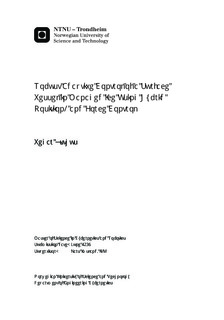| dc.description.abstract | Studies done in recent years have shown a signicant decline in the coverage of arctic sea ice. This trend has made the Arctic more accessible and has resulted in expanded naval activity in this region. Furthermore, an increasing desire among international petroleum operators to extend their operations towards the Arctic have resulted in vast investments in the development of these areas.The increasing development of the oil and gas industry in the Arctic region makes riseto several challenges concerning navigation and control of the vessels operating in these waters. Although the trend shows a decrease in the thick multi-year ice cape covering most of the Arctic, a proportional increase in thinner ice oes is observed. The technologyfor vessel stationkeeping used in open waters today, known as Dynamic Positioning (DP), has not shown to perform suciently well in areas where ice is present.In this thesis two model reference adaptive control schemes are implemented as a meanto achieve automatic vessel control in an ever changing sea ice environment. The rstscheme is an indirect MRAC scheme, which aims to regulate the vessel dynamics withrespect to the environment in order to achieve convergence to desired positions.The second scheme is an extended MRAC scheme, referred to as MRAHFC, which incorporateshybrid force control into the vessel DP control system. Force control aims to regulatethe vessel-environment interaction force dynamics in order to reduce environmentalinuence.The proposed control schemes are demonstrated and compared with a reference PDcontroller with acceleration feed-forward. The results suggest that the indirect MRACperforms better relative to the reference controller in regulating the vessel to a stationary setpoint. Moreover, energy consumption is reduced, as the vessel applies less force in the process. However, neglection of cross terms in the system models results in drift-offs and excessive thrust force due to sway-yaw interaction. The results for the MRAHFC scheme show that the force controller does operate as intended. However, in the form demonstrated, it does not reduce energy consumption any further. Nor does it result in a noteworthy reduction in environmental inuence, compared to the classic MRAC.The results from the case study furthermore indicate that adaptive control might constitute as an enhancement relative to conventional systems. Nevertheless, more work has to be done in order to enhance the MRAC performance, as it does not, in the implemented form, account for cross terms in the system models. Enhancing the MRAC performance thus implies developing an adaptive control system for multi-variable systems. Such a development is believed to pose as a possible improvement of force control in this regard as well, as precise force control would require knowledge of every term in the system models. Finally, further work should be done in order to optimize the proposed control schemes with respect to fuel consumption and choice-of-route through the ice. | nb_NO |

